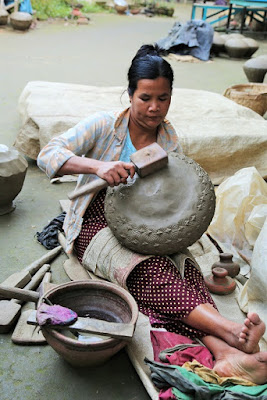This is my last post with content and images from our Myanmar visit. I hope you've enjoyed an armchair tour of Myanmar.
Yandabo "Pottery" Village
Yandabo was the site of the signing of the First Anglo-Burmese War Treaty. After two years of intensive fighting, the treaty was signed in 1826. The agreement is thought to be the beginning of the end of Burmese independence. Key areas of Burma were ceded to the British as well as hefty fees ($5 million USD in current dollars) paid by Burma to Britain.
The village is now primarily focused on agriculture and using clay from the riverbanks to make pottery. One person can make about 40-60 pots in a single day.We visited a pottery maker during one of our excursions.
 |
| © 2016, R. Ono |
 |
| Solar Panels Provide Residential Electricity, © 2016, R. Ono |
 |
| © 2016, R. Ono |
 |
| © 2016, R. Ono |
 |
| © 2016, R. Ono |
 |
| © 2016, R. Ono |
Amarapura
Amarapura is a township of Mandalay. The town is known for its silk and cotton weaving. Amarapura has its roots as a royal capital. In 1783, King Bodawpaya of the Konbaung Dynasty built his palace in Amarapura. Subsequent Kings moved the capital to Ava and then back to Amarapura in 1842. King Mindon, the next to last Burmese King, moved the capital to Mandalay. The Amarapura royal palace was dismantled and reconstructed in Mandalay.
While in Amarapura, we made a sunset visit to U Bein bridge. This bridge was built in 1850 and is considered to be the longest and oldest teakwood bridge. The bridge length is less than a mile and has spans that can be removed to permit tall ships to pass. The teakwood posts have been sunk seven feet into the lakebed. Many of the teakwood bridge posts came from previous royal palace structures in Ava.
Sagaing Hill
Sagaing is a township of Mandalay. It is about 12 miles southwest of Mandalay. During our visit, we began with a morning offering to local monks at the riverbank. AMA setup a tent and carpet area so that we could provide packets of food and living items (such as paper, pens, soap) for us to give as an offering. Under Buddhism, such offerings are believed to accumulate merits for the donor. Merits help spiritual growth and good deeds provide benefits throughout one's life or reincarnations.
 |
| © 2016, R. Ono |
 |
| © 2016, R. Ono |
Afterwards, we loaded onto buses and continued our Sagaing visit to a school, nunnery and SoonOoPonyaShin pagoda..
 |
| © 2016, R. Ono |
 |
| © 2016, R. Ono |
 |
| © 2016, R. Ono |
 |
| Lunch Preparation, © 2016, R. Ono |
 |
| © 2016, R. Ono |
 |
| © 2016, R. Ono |
 |
| © 2016, R. Ono |
 |
| Hazy Morning,© 2016, R. Ono |
Mingun
 |
| © 2016, R. Ono |
For us, Mingun was our last excursion before leaving Myanmar for Viet Nam. During our Mingun excursion, we visited Mingun Pahtodaygyi, the Mingun Bell and Myatheinan Pagoda.
 |
| © 2016, R. Ono |
 |
| © 2016, R. Ono |
Pahtodawgyi is an incomplete stupa started by King Bodawpaya, founder of Amarapura. Started in 1790, plans called for the stupa to rise 450 feet in height. Construction labor for this massive project was performed by prisoners and slaves. Work on the stupa ceased as the King was thought to have believed that completion of the stupa would mark the end of his country or, perhaps, his own death. The incomplete stupa is 164 feet in height and earthquake damage is clearly evident.
 |
| © 2016, R. Ono |
 |
| © 2016, R. Ono |
Along our walk, we stopped to view the 90 ton Mingun Bell. This bell is the second largest ringing bell in the world and was intended to be placed into Pahtodawgyi (the largest ringing bell is in China). Our final stop was the Myatheinan Pagoda. This final stop coincided with a terrific opportunity to photograph two young novices in their maroon robes, highlighted against the white pagoda.
 |
| © 2016, R. Ono |
 |
| © 2016, R. Ono |



























No comments:
Post a Comment